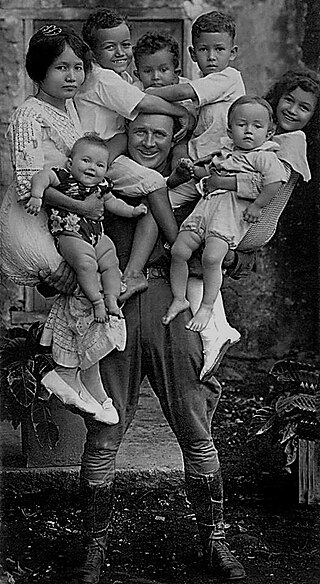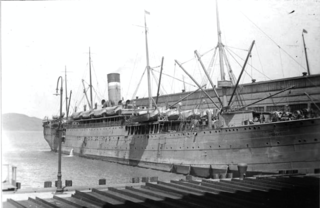
The Philippine Constabulary was a gendarmerie-type military police force of the Philippines from 1901 to 1991, and the predecessor to the Philippine National Police. It was created by the American occupational government to replace the Spanish colonial Guardia Civil, happened on the 19th century history of the Philippines. It was the first of the four branches of the Armed Forces of the Philippines. On January 29, 1991, it was merged with the Integrated National Police to form the Philippine National Police.

The Philippine–American War, known alternatively as the Philippine Insurrection, Filipino–American War, or Tagalog Insurgency, emerged following the conclusion of the Spanish–American War in December 1898 when the United States annexed the Philippine Islands under the Treaty of Paris. Philippine nationalists constituted the First Philippine Republic in January 1899, seven months after signing the Philippine Declaration of Independence. The United States did not recognize either event as legitimate, and tensions escalated until fighting commenced on February 4, 1899 in the Battle of Manila.

Nueva Ecija, officially the Province of Nueva Ecija, is a landlocked province in the Philippines located in the Central Luzon region. Its capital is the city of Palayan, while Cabanatuan, its former capital, is the largest local government unit (LGU). Nueva Ecija borders, from the south clockwise, Bulacan, Pampanga, Tarlac, Pangasinan, Nueva Vizcaya and Aurora. The province is nationally known as the Rice Granary of the Philippines, producing the largest rice yield in the country.

West Visayas State University is a public normal research university located in La Paz, Iloilo City, Western Visayas region of the Philippines. It was established in 1924 as Iloilo Normal School under the tutelage of the Thomasites, but dates back its founding in 1902 as a part of Philippine normal school system with Iloilo National High School established by the American colonial government. It later became West Visayas State College in 1965 and acquired its university status becoming West Visayas State University in 1986.

American settlement in the Philippines began during the Spanish colonial period. The period of American colonialization of the Philippines was 48 years. It began with the cession of the Philippines to the U.S. by Spain in 1898 and lasted until the U.S. recognition of Philippine independence in 1946.

The Philippine Republic, now officially remembered as the First Philippine Republic and also referred to by historians as the Malolos Republic, was established in Malolos, Bulacan during the Philippine Revolution against the Spanish Empire (1896–1898) and the Spanish–American War between Spain and the United States (1898) through the promulgation of the Malolos Constitution on January 23, 1899, succeeding the Revolutionary Government of the Philippines. It was formally established with Emilio Aguinaldo as president. It maintained governance until April 19, 1901. Following the American victory at the Battle of Manila Bay, Aguinaldo returned to the Philippines, issued the Philippine Declaration of Independence on June 12, 1898, and proclaimed successive revolutionary Philippine governments on June 18 and 23 of that year.

The history of the Philippines from 1898 to 1946 is known as the American colonial period, and began with the outbreak of the Spanish–American War in April 1898, when the Philippines was still a colony of the Spanish East Indies, and concluded when the United States formally recognized the independence of the Republic of the Philippines on July 4, 1946.

The Philippine Normal University is a public coeducational teacher education and research university in the Philippines. It was established in 1901 through Act No. 74 of the Philippine Commission "for the education of natives of the Islands in the science of teaching". It has campuses in Manila, North Luzon, South Luzon, Visayas, and Mindanao. Pursuant to Republic Act No. 9647, it is the country's National Center for Teacher Education.
During the United States colonial period of the Philippines (1898–1946), the United States government was in charge of providing education in the Philippines.

USAT Thomas was a United States Army transport ship purchased on 26 July 1898 for Spanish–American War service. Thomas served with the Army Transport Service (ATS) until retired in 1929.

The Taft Commission, also known as the Second Philippine Commission, was established by United States President William McKinley on March 16, 1900, following the recommendations of the First Philippine Commission, using presidential war powers while the U.S. was engaged in the Philippine–American War.

La Consolación College Manila is a private Catholic basic and higher education institution run by the Augustinian Sisters of Our Lady of Consolation (ASOLC) in the City of Manila, Philippines. It was founded by the Augustinian Sisters in 1902 when the Apostolic Nuncio to the Philippines offered ten Filipino nuns from the Augustinian Sisters of Our Lady of Consolation a house near the Basilica of San Sebastián.

The Treaty of Manila of 1946, formally the Treaty of General Relations and Protocol, is a treaty of general relations signed on July 4, 1946, in Manila, the capital of the Philippines. It relinquished U.S. sovereignty over the Philippines and recognized the independence of the Republic of the Philippines. The treaty was signed by High Commissioner Paul V. McNutt as representative of the United States and President Manuel Roxas as representative of the Philippines.

Wenceslao "Bintao" Quinito Vinzons Sr. was a Filipino patriot and leader of the Philippine armed resistance against the Japanese invasion in World War II. He was the youngest delegate to the 1935 Philippine Constitutional Convention. For leading demonstrations as a student leader, he was dubbed the "Father of Student Activism in the Philippines" when he, along with Narciso J. Alegre and future Senator and Vice-President Arturo M. Tolentino, founded the Young Philippines Party.
Abraham Van Heyningen Hartendorp (1893–1975), commonly known as A.V.H. Hartendorp or A.V. Hartendorp, was an American writer, editor, Thomasite, and Filipinologist. He was the founder and publisher of the Philippine Magazine, a magazine formerly known as Philippine Education Magazine when it was still a publication intended for public school teachers in 1904. When Hantendorp bought the magazine in 1924, he officially changed its name into Philippine Magazine and became the "most prestigious outlet" for aspiring writers in the Philippines. In 1930, Hartendorp dedicated the magazine to "full recording of all phases of the present cultural development of the Philippines" up to "the Philippine Renaissance." Hartendorp catered the Philippine Magazine to an "urban-based audience of educated elites", particularly "schoolteachers, employees of the government, professionals, and university intellectuals". Hartendorp was also a former editor of The Manila Times newspaper.

The Camarines Sur National High School, also called CamHi, is the oldest national high school in Camarines Sur and one of the biggest public secondary schools in the Bicol Region, Philippines, having a student population of 11,899 in the school year 2021–2022. It was established in 1902.

The United States Military Government of the Philippine Islands was a military government in the Philippines established by the United States on August 14, 1898, a day after the capture of Manila, with General Wesley Merritt acting as military governor. General Merrit established this military government by proclamation on August 14, 1898.

Tarlac National High School, formerly Tarlac High School, is a public high school in Tarlac City, Philippines. Established on September 2, 1902 by American Thomasites, it is one of the oldest public high school system in the country. It is one of the largest secondary schools in the region with over 7,000 student population.

Esteban Raymundo Abada was a Filipino politician who served as senator from 1949 until his death in 1954. He also held the position of President pro tempore of the Senate of the Philippines briefly in 1952. Prior to becoming a senator, Abada held various posts in the Department of Education.

















